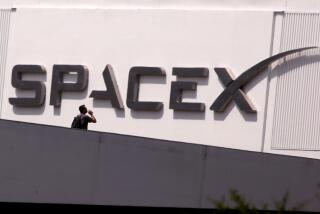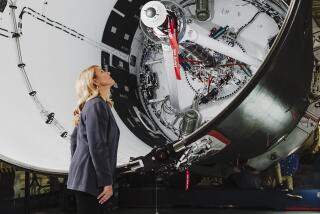Defense Cuts Worry Departing Scientist
When Richard R. Weiss watches “Star Trek,” he sees the future. A starship Enterprise propelled by dilithium crystals is not so far beyond research Weiss has been supervising at Phillips Labs, a 65-square-mile rocket-testing site in the northeast corner of Edwards Air Force Base.
Thirty-five years of working on the technology that powers rockets into space--including contributions to the Apollo moon missions, the space shuttle and Strategic Defense Initiative technology--has given him a unique perspective on the relationship between the past and present, science fact and science fiction.
Weiss, 58, left his post Friday as head of Phillips Labs’ propulsion directorate at the Antelope Valley base, where the technology for most of the country’s missile-launch systems and the space shuttle’s main engine were developed. After a cross-country drive, he will start work at the Pentagon as a technical adviser to the Air Force and the Department of Defense.
He’ll be telling the decision makers what is--and isn’t--technologically feasible for the future. The fictional dilithium crystals, for example, are a theoretical extension of scientific principles behind the eraser-textured solid rocket fuels being developed today.
Weiss, an avowed Trekkie, thinks the series isn’t much of a stretch. “I believe in ‘Star Trek.’ It’s all within the realm of possibility.”
Weiss is a far cry from the image of a mad scientist in a white coat, or even a typical Trekkie. He favors the bureaucrat’s dark suits and red ties. His gray hair is neatly combed. He is reserved, although there is humor in his brown eyes. It’s clear he doesn’t like to sit still for interviews. After an hour or so, he grows impatient.
Although his departure from Phillips Labs gives him an opportunity to reflect on the past and dream about the future, Weiss is worried about the present. During an interview at his office, decorated with pictures of rockets and missiles, Weiss said he is concerned about the current climate of defense cost-cutting and its impact on rocket research.
He is departing at a time of uncertainty for Phillips’ research facility at Edwards. The Air Force has announced plans to merge the lab with Phillips’ headquarters lab in Kirtland, N.M., to create one of four “super-laboratories” for space and missile technology.
Weiss fears that if the military cuts go too deep, technological breakthroughs will be fewer, unless other funding sources can be found.
“Most scientific activities have come out of defense investment,” he said. “Without that being done, I worry about what’s going to happen in the future.”
Defense-supported research isn’t just about developing costly and controversial weapons systems. For example, Weiss said, the satellite technology that airline pilots now use for computer navigation was first developed during SDI research.
It doesn’t take a rocket scientist--the popular expression inevitably draws a chuckle from Weiss--to recognize that the days of big defense budgets are over. But Weiss sees another set of challenges brought by a new world order. Scientists are beginning to shift their focus from weapons to space travel and commercial projects, and are trying to develop lighter, cheaper and cleaner rockets--even solar-powered rockets.
Weiss said he will be working to improve relations between the Air Force, Department of Defense and the National Aeronautics and Space Administration for future space launch programs.
In Washington, he will be tapping into more than three decades of experience that parallel the aerospace industry’s biggest growth spurt.
In 1958, when Weiss was originally assigned to the Edwards base and what would later be known as Phillips Labs, astronaut Chuck Yeager had broken the sound barrier in the rocket-powered X-1 aircraft, but space travel was still the stuff of science fiction.
He went to work as an engineer at the Rocket Propulsion Laboratory and the Astronautics Laboratory as a young Air Force lieutenant, testing the THOR missile system. He left the Air Force in 1961 but stayed at the lab to research liquid-rocket-fuel combustion technology. Between 1965 and 1974, he managed most of the lab’s engineering divisions.
He was promoted to chief scientist of the Rocket Propulsion Laboratory in June, 1974, and was the first director of the lab’s SDI, or Star Wars, technology office. In 1989, he was named director of the Astronautics Laboratory. In 1990, the lab was incorporated into the Phillips Laboratory.
The lab at Edwards has had a hand in every major space and missile system. Besides the Apollo mission, Star Wars and the space shuttle, the lab has contributed to rocket propulsion developments for the Titan, Atlas, Peacekeeper, Minuteman and other strategic missiles.
Weiss said he will miss his work at Phillips and living in the high desert, but adds, “Now’s a good time to leave.”
“We’re in the technology business here and we’re really trying to project the country’s needs 10 years downstream,” he said. The most immediate needs, he said, are better weapons systems to maintain a competitive edge while scientists work on making space accessible.
The first country to position itself in space owns the future, Weiss believes.
“We’ll be seeing airplane-type vehicles taking commercial payloads into space. I view the shuttle as the Model A version of what can be done,” he said.
More to Read
Sign up for Essential California
The most important California stories and recommendations in your inbox every morning.
You may occasionally receive promotional content from the Los Angeles Times.










